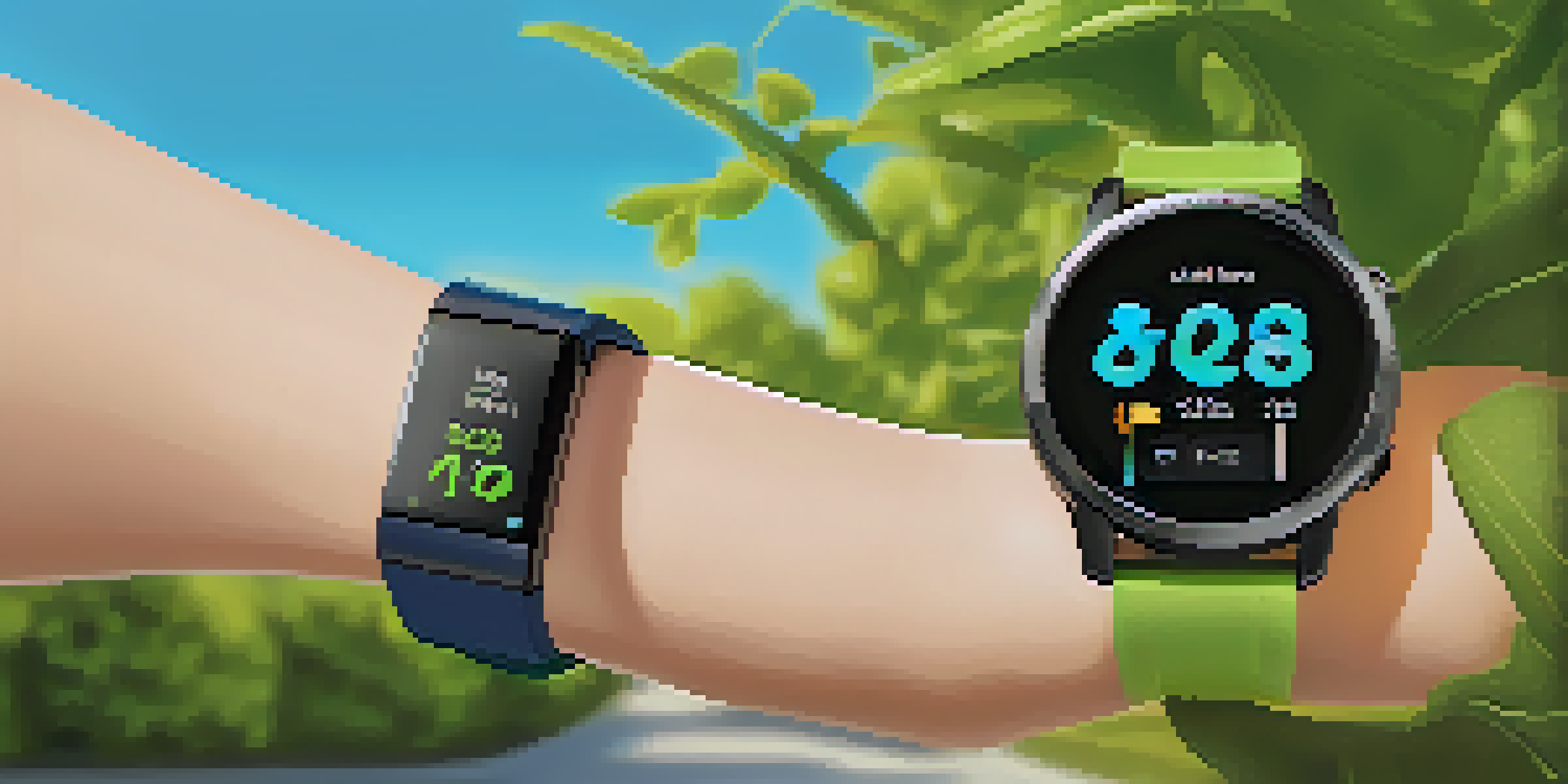How Wearable Devices Are Shaping the Future of Fitness

The Rise of Wearable Fitness Technology
Wearable fitness technology has surged in popularity over the past decade, becoming a staple for fitness enthusiasts. Devices like smartwatches and fitness trackers provide real-time data, allowing users to monitor their activity levels and health metrics effortlessly. This trend reflects a broader shift towards tech-driven personal health management, as more people seek ways to optimize their workouts.
Technology is best when it brings people together.
For instance, a simple fitness tracker can count steps, track heart rates, and even monitor sleep patterns. This wealth of information empowers users to set more informed fitness goals. As technology continues to advance, we can expect even more sophisticated features that cater to individual health needs.
Moreover, the accessibility of these devices has made fitness tracking a part of everyday life for many. It's no longer just athletes who benefit from this technology; casual gym-goers and health-conscious individuals are now part of this digital fitness revolution.
Personalized Fitness Insights Through Data
One of the significant advantages of wearable devices is their ability to provide personalized insights based on collected data. For example, a device can analyze your workout patterns and suggest adjustments to optimize performance. This level of customization leads to more effective training regimens tailored to individual needs.

Imagine having a personal trainer available 24/7 at your wrist, ready to give feedback and adjust your training based on real-time stats. This capability not only enhances the effectiveness of workouts but also keeps users motivated and engaged in their fitness journey. When you see your improvements tracked over time, it creates a sense of accomplishment.
Wearables Empower Personal Health
Wearable fitness technology provides real-time data, enabling users to monitor their health and optimize their workouts.
Furthermore, these insights can help users identify trends in their health and fitness, allowing for proactive adjustments. This proactive approach can lead to improved overall health and wellness, making fitness more sustainable in the long run.
The Role of Gamification in Fitness
Gamification in fitness, powered by wearable devices, is changing the way we approach workouts. Many wearables incorporate game-like elements, such as challenges, rewards, and leaderboards, making exercise more engaging. This playful approach not only motivates users to work out but also fosters a sense of community among users.
The future is already here – it's just not very evenly distributed.
For instance, virtual competitions that allow users to compare their performance with friends or the global community can drive individuals to push their limits. This friendly competition can be a powerful motivator, encouraging people to stick with their fitness routines. Who wouldn't want to beat their friend’s step count?
Moreover, the integration of gamification keeps users accountable and makes fitness feel less like a chore and more like a fun activity. As more devices adopt these features, we can expect to see a shift in how people perceive fitness, making it a more enjoyable and rewarding experience.
Integration with Mobile Apps and Platforms
Wearable devices often work in tandem with mobile apps, creating a seamless ecosystem for fitness tracking. These apps allow users to dive deeper into their data, visualize progress, and set actionable goals. By combining data from various sources, users can gain a holistic view of their health and fitness journey.
For instance, many fitness apps now integrate with popular wearables to track not just workouts but also nutrition, hydration, and even mental well-being. This comprehensive approach provides users with the tools to maintain a balanced lifestyle. Having everything in one place simplifies the process and encourages consistency.
Gamification Boosts Fitness Engagement
Incorporating game-like elements in wearables makes exercising more enjoyable and fosters a sense of community among users.
Additionally, sharing progress on social media through these apps can enhance motivation as users celebrate milestones with friends and family. This connectivity fosters a supportive community that can inspire individuals to stay committed to their fitness goals.
Health Monitoring: Beyond Fitness
Wearable devices are not just about fitness; they also play a crucial role in health monitoring. Many devices now come equipped with features that can track vital signs like heart rate, blood oxygen levels, and even ECG readings. This capability can alert users to potential health issues before they become serious.
For example, if a wearable detects an irregular heartbeat, it can prompt the user to seek medical advice, potentially saving lives. This shift from fitness-centric technology to comprehensive health monitoring signifies a growing awareness of preventive health care. The data collected can also be shared with healthcare providers for better-informed medical decisions.
As more people embrace these health-monitoring features, we can expect a culture shift towards proactive health management. This evolution not only empowers individuals but also contributes to a healthier society overall.
The Future of Wearable Fitness Technology
Looking ahead, the future of wearable fitness technology is incredibly promising. As advancements continue, we can expect devices to become even more sophisticated, incorporating AI and machine learning to provide smarter insights. These technologies will allow wearables to learn from users' habits and tailor recommendations more accurately.
Additionally, as connectivity improves, wearables will integrate with smart home devices and other technology, creating a cohesive ecosystem for health and wellness. Imagine your wearable adjusting your home environment based on your activity levels or recovery needs. This interconnectedness can enhance the overall fitness experience.
Health Monitoring Enhances Safety
Wearable devices extend beyond fitness by tracking vital signs and alerting users to potential health issues, promoting proactive care.
Moreover, as research on health and fitness evolves, wearables will likely adapt to include new metrics and features that align with the latest findings. This continuous improvement ensures that users always have the best tools available to help them lead healthier, more active lives.
Challenges and Considerations in Wearable Technology
Despite the many advantages of wearable fitness devices, there are challenges and considerations to keep in mind. Privacy and data security are paramount concerns, especially as these devices collect sensitive health information. Users must be informed about how their data is used and protected.
Additionally, the accuracy of the data provided by wearables can vary. Users should be aware that while these devices offer valuable insights, they are not infallible. It's essential to complement wearable data with professional advice and personal judgment to ensure a balanced approach to fitness.

Lastly, the cost of high-quality wearable devices can be a barrier for some individuals. As technology advances, it is crucial to make these devices accessible to everyone, ensuring that the benefits of wearable fitness technology can be enjoyed by all, regardless of budget.